Entering the Georgia Tech laboratory of Flavio Fenton is a little like walking into a toy store for dynamicists: setups ranging from relatively simple candle and saltwater experiments to more complicated cardiac tissue preparations are visible, and everyone seems to be having fun. With two postdocs, a visiting professor from Brazil, three graduate students plus a fourth visiting from Mexico, and an assortment of undergraduates from multiple disciplines, the lab is buzzing with energy.
For Fenton, a native of Mexico City, the lab is exactly what he wants at this point in his career: great people working on a variety of experiments related to his ongoing interests in nonlinear dynamics. The lab combines experimental work with computation and theory, and the diversity in projects is mirrored in the diversity of personnel he has assembled.
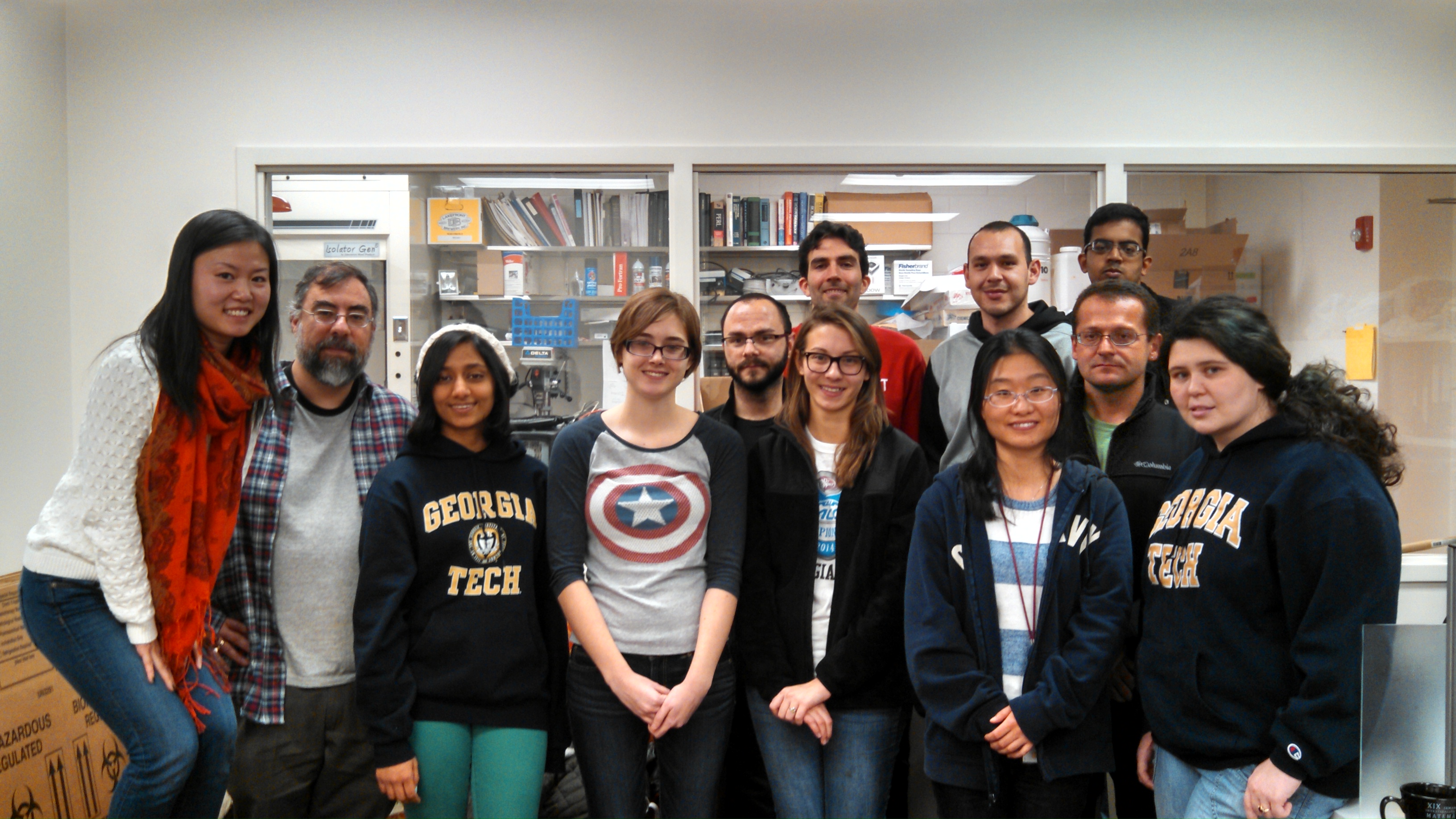
The lab personnel are all smiles.
For example, Fenton’s three Georgia Tech graduate students are all women studying physics, a STEM field known for a low percentage of female participants. Diandian Diana Chen, Yanyan Ji, and Andrea Welsh all traced their interest to working in the lab from their first year in graduate school, when Fenton joined other faculty in a series of brief lectures describing their research interests to new students. “He showed those very cool demonstrations like the BZ [Belousov-Zhabotinsky] reaction, with colors changing, and I found it fascinating,” Ji said of Fenton. Welsh agreed that she found it “interesting that he did a mixture of computation, experiments, and theory, because I was having a hard time making that decision.” Chen missed that presentation, but after hearing from friends about his talk, she approached Fenton on her own and asked him to show her an experiment. To her surprise, he did so. “He was so open, and I wasn’t used to that,” she said. “I liked that a lot.” All three women decided to study with Fenton and have become mainstays in the lab.
On the experimental side, cardiac dynamics, Fenton’s traditional research area, has been a primary focus. Together with postdoctoral researcher Ilija Uzelac, Fenton has focused on developing and refining low-energy approaches to cardiac defibrillation. Current defibrillatory shocks, which are the standard for treating life-threatening spiral or scroll waves of electricity circulating through the heart at high frequencies and overriding signals from the natural pacemaker, require high energies that can damage the heart as a side effect of resuscitation. Fenton and collaborators at Cornell University and the Max Planck Institute for Dynamics and Self-organization have published a novel approach in which a series of gentler shocks progressively synchronizes the tissue, thereby extinguishing high-frequency wave sources and allowing the pacemaker to resume its role. Optical mapping recordings in live cardiac tissue, which use voltage- and/or calcium-sensitive fluorescent dyes to record dynamics at high spatial and temporal resolution, are key components of assessing the efficacy of defibrillation techniques and verifying that synchronization is the mechanism at work. Related projects include studying how voltage and calcium signals are related during normal and abnormal cardiac dynamical states.
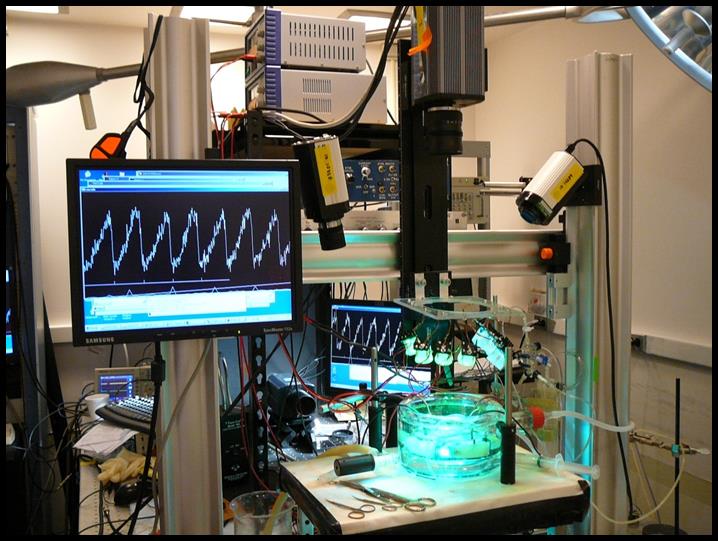

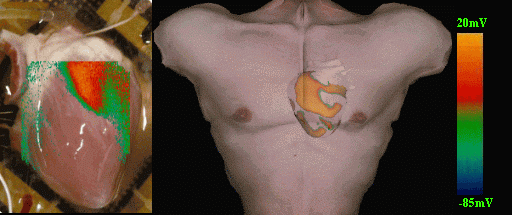
Cardiac imaging setup; movies of fibrillation and a stable spiral wave;
simulated spiral wave.
Spiral waves have been a favorite topic for Fenton since his days as graduate student at Northeastern University. Although he is best known for analyzing spiral waves in the heart, Fenton recently studied spiral waves in collective behavior by filming a group of nearly 600 human volunteers at Georgia Tech acting according to rules to produce spiral wave behavior. Similar to an experimental cellular automata model, participants were arranged in a grid and instructed to raise their hands if at least one of their four immediate neighbors (left, right, up, or down) had his or her hands raised. With participants holding brightly colored paper, patterns were easy to detect in movies recorded by Welsh from an elevated position nearby. In the first experiment, Fenton and his colleagues were able to organize a traveling wave, a
spiral wave,
and a state of spiral wave breakup akin to chaotic behavior. Fenton and mathematics graduate student Jairo Rodriguez, visiting from Universidad de Sonora in Hermosillo, Mexico, are working on modeling the observed behavior, including novel anticipatory behavior on the part of the humans involved. They also are hoping to repeat the experiment with more people and possibly new rules to study different dynamical regimes.
Several other ongoing experiments in the lab involve novel oscillators. One project involves a candle oscillator in which, essentially, a candle is threaded onto a thin rod at its center and then burned at both ends. As wax drips from the two lit ends of the candle, the mass distribution changes, and the candle rotates within the plane perpendicular to the axis of the rod. Postdoctoral researcher Gregory Byrne has been charged with advancing the project, with help from first-year physics undergraduate student Mary Elizabeth Lee. Byrne was excited about a change of pace in working on the project; when he began, he had been working exclusively on theoretical and numerical work. “Sometimes you need a break from that,” he says. In fact, this was Byrne’s first experience working with an experimental system. He and Fenton started small by putting two birthday candles together and eventually scaled up to a precisely engineered system with a special bearing to minimize friction and a track to allow the rod to roll parallel to the floor as the system mass changes. Byrne says the idea of the candle oscillator is very simple but that the dynamics can exhibit complex reversals, somewhat similar to those found in a Lorenz water wheel. “Once lit, the wax dripping shifts the center of mass,” he says. “It creates this forcing that drives the oscillation.” The team already has written equations of motion for the system. “What’s difficult is to model the nonlinear forcing due to the melting wax,” Byrne says. So far they have extended earlier theoretical work limited to small angles and have found periodic orbits in the candle’s motion. They are also working to show robustly that the system is chaotic.
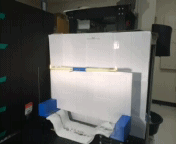
The candle oscillator can even complete a full rotation!
The saline oscillator is another prominent experimental setup in the lab. The oscillator consists of a two-chambered box, with one chamber containing fresh water and the other salt water. A narrow orifice connects the two chambers. Density differences then drive an oscillation, with flow direction through the orifice alternating in direction. Chen oversees the project, which also involves first-year undergraduate physics major Gwen Kvasnicka. “It’s really simple, but it shows a lot of interesting behaviors,” she says. “You can manipulate it very easily and it’s really cheap to build.” It is possible to record an electric signal resembling a biological action potential from the flow. Those signals can be recorded during different external conditions to obtain period-2 and period-doubling behavior, and possibly chaos. The team is working on writing an equation relating the different system parameters to describe the observed dynamics.


Upper: Saline oscillator setup. Lower: Saline oscillator at work, with fluid in one compartment colored dark blue. The coloring permits only the downward jet to be visible, but the flow in fact reverses direction. The oscilloscope records an electrical signal similar to biological action potentials.
Another experiment involves synchronization of Mexican jumping beans. The beans, which are actually moth larvae embedded in seed pods, “jump” when heated as the larvae attempt to find a cooler location. Welsh has been overseeing experimental, theoretical, and computational studies of their system, in which the beans are coupled by string and exposed to light as a heat source to force the system. So far the system has exhibited wave behavior under certain conditions; the team believes that the initial phases are causing the waves, but further studies are needed.
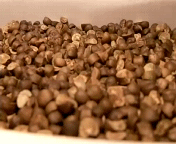
Unconstrained jumping beans.
Welsh also has been in charge of experiments with Newton’s beads, which are long strings of beads that are “poured” from a higher container to a lower container by tugging on the string initially and letting go once gravity takes over; undergraduate Madeline Lazar also works on the project. What is noteworthy about Newton’s beads is that the string forms an upward arc before changing direction and falling down. The arcs can be unexpectedly long, and spiraling behavior can occur.

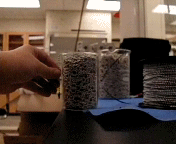
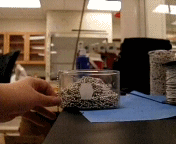
Newton’s beads snapshot and movies.
Computation forms an important focus of the lab as well. Visiting computer science professor Marcelo Zamith from the Federal University Rural of Rio de Janeiro has been working with Byrne and Rodriguez to assess the performance of different graphics cards for simulations of cardiac wave dynamics. Zamith met Fenton at the 3rd Conference of Computational Interdisciplinary Science in Asuncion, Paraguay, where he learned that the heart simulations used the same structure he had already used for oil prospecting in his previous work at a Brazilian company. The team has analyzed how CUDA C and OpenACC perform for different cardiac models on multiple graphics cards to learn the best ways to optimize codes using low-cost hardware options. In another numerical effort, Ji has been quantifying the accuracy of difference numerical methods for solving the PDEs that describe cardiac wave propagation.
Several different projects are focused on aspects of cardiac electrical dynamics using a mixture of theory and computation, which is where Fenton himself got his start in graduate school. Ji has combined various models of cardiac cellular behavior with a model of cellular contraction and also has studied the effects of time-varying cellular coupling on wave propagation and pattern formation. Chen is continuing to use computation to study alternations in action potential height and the role this type of dynamics may play during cardiac arrhythmias. Rodriguez has worked on modeling the forces governing contraction and repulsion of interacting scroll waves as a potential force and developing equations that govern the motion of the phase singularities around which the waves rotate.
Members of the lab appreciate that theory, computation, and experiment all play a role. Chen has been pleased to use numerical simulation as an additional investigative tool. “I did not realize I would be doing so much coding,” she says. “I am not doing what I expected, but in a really good way.” In a similar manner, Rodriguez has been delighted to see equations come to life. “I’m a mathematician back home so I only did theory,” he says. “A system of PDEs is just numbers and that’s it. Here I have learned what is the role of those numbers: potassium, calcium. It gives you another picture.” Zamith agrees that seeing actual experiments is helpful. “The lab facilities are quite different from Brazil,” he says. “I’ve never been in a physics lab. It’s different.” Welsh appreciates the variety. “I like all the creative ideas; it gives me a lot of options,” she says.
All agree that the human dynamics play a large role in making the lab so enjoyable. “I think it’s a very friendly lab environment,” Ji says. Rodriguez will be returning to Mexico in March with mixed emotions. “I really like it. I’m going to miss it a lot,” he says. “I have learned a lot of things—not just in academia, but in general.” Chen agrees that the lab is a great place to work and develop as a student. “I’m becoming what I want to be, a better scientist, better at thinking about problems, so I’m very happy,” she says. “I always think science is fun, and this is fun!”